The Scaled Agile Framework (SAFe) has become the de facto standard for scaling agile product development. OKR (Objectives and Key Results) has established itself as a technique for formulating objectives. As objectives play an important role in product development, we would like to shed light on the role of OKRs in SAFe in this article.
We will first look at the basics of SAFe and OKRs. Then, in a second step, we show the similarities / differences between SAFe and OKRs.
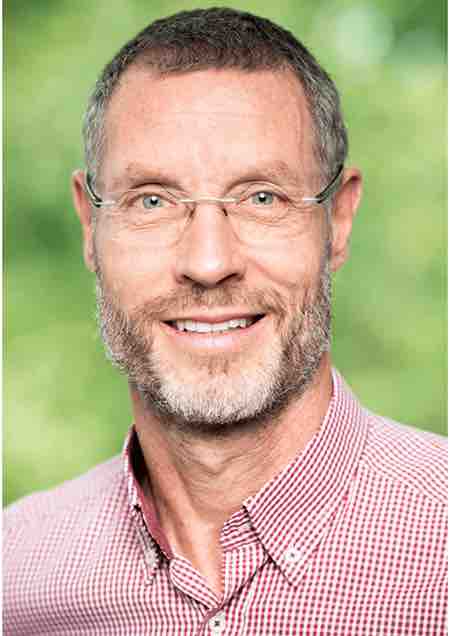
What is SAFe?
Agility offers solutions to the challenges of the digital age. Markets and customer requirements have become more dynamic and complex. Companies must therefore become more adaptive and responsive.
Agile concepts are already being implemented in many companies. The first step is often for teams to switch to agile and autonomous working. However, improving individual project teams is no longer enough. This is why many companies are looking for solutions that make the entire organization agile.
If you look around the market, you will find several frameworks that offer patterns for scaling your own organization in an agile way. There are several models on the market: Scaled Agile Framework (SAFe), Large-Scale Scrum (LeSS), Disciplined Agile, Nexus, Scrum@Scale or the Spotify model. The market leader in scaling frameworks is SAFe with a market share of around 35%.
Source: 14th annual State of Agile Report
What is the SAFe Framework?
SAFe is a publicly available knowledge base based on techniques, values and principles of Lean and Agile. The techniques ("mechanics") are important, but the principles provide the underlying philosophy and explain the "why".
Firmly anchored in the knowledge bases of Lean and Agile, SAFe is a multi-level organizational model for business agility. The Lean-Agile mindset is the cornerstone for an improved management approach and an improved corporate culture.
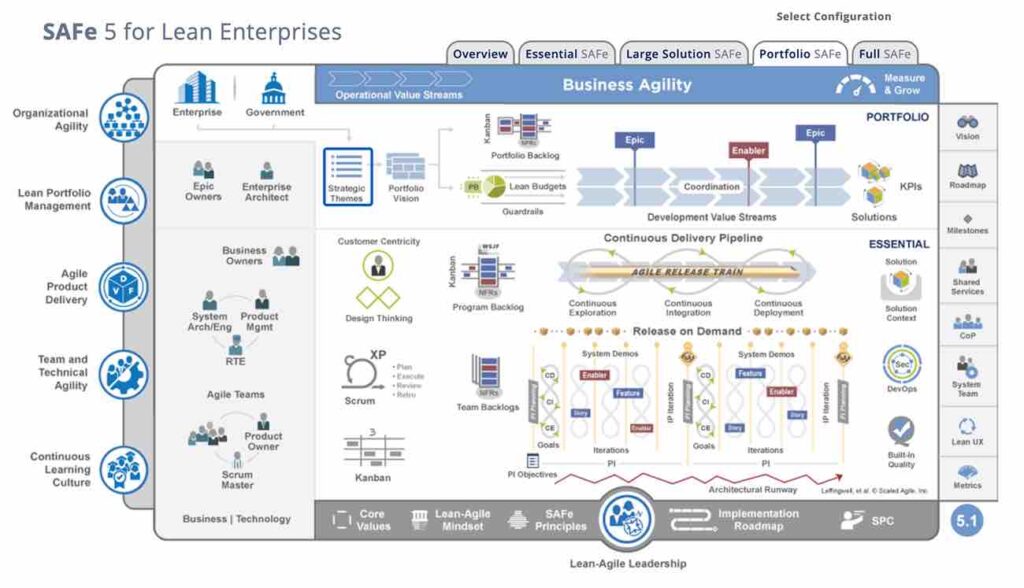
The SAFe "Big Picture" provides an entry point into the framework of proven working patterns for Lean-Agile on a large scale. Each object of the Big Picture on the SAFe website is clickable and provides detailed information on the selected topic.
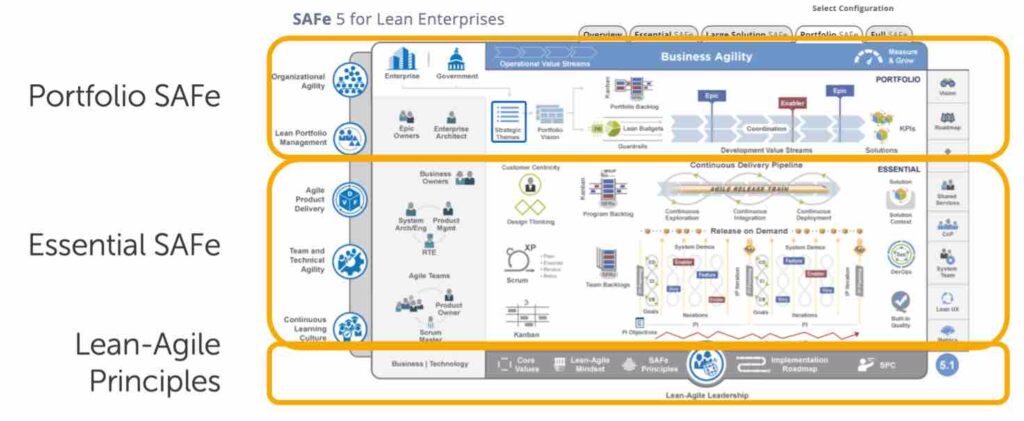
The SAFe framework can be divided into three configurations. Essential SAFe is the core of the framework and includes the execution of epics and features, the minimum roles and necessary events. This core area is established and consolidated on the market.
The configuration around Portfolio SAFe deals with strategic development. There have been many enhancements and adjustments here in recent years. As explained below, this configuration also includes the implementation of the OKRs.
An Agile Release Train
The core of SAFe is the synchronized execution of initiatives through a so-called "Agile Release Train" (ART). An ART is an entrepreneurial "cell" of 6-12 highly integrated cross-functional teams working in a Scrum or Kanban fashion. The ART delivers and integrates an increment of the solution in each two-week sprint.
The entire ART comes together approximately every quarter (typically every 5 sprints) to hold an "all-hands" event to demonstrate/review key deliverables with business stakeholders, assess progress on the roadmap, and detail and commit plans for the next quarter.
What are OKRs?
OKRs stands for "Objectives and Key Results". OKR is a method for companies, divisions and teams to create alignment and support their ambitious goals in measurability. Two things make up OKR: One is about making business objectives (the Objectives) measurable with a few key results each (the Key Results). Secondly, OKR involves regularly reviewing and adjusting the objectives.
An important aspect of the OKR approach is to define the key results as "outcomes" and not as "outputs".
Another important aspect of OKR is to frequently track, evaluate and, if necessary, adjust the defined targets. This is normally done on a quarterly basis. In this way, it is possible to regularly check whether the target orientation is still correct or whether it may need to be adjusted. In this way, it is possible to respond flexibly to new framework conditions.
The aim of OKRs is to promote communication within the company between the various departments and levels. In addition, OKRs are intended to ensure that everyone involved is moving in the same direction, with clear priorities and at a constant pace.
How does the SAFe framework integrate OKRs?
At the strategy/portfolio level of SAFe, proven practices and techniques for strategy development and lean-agile portfolio management are integrated. For example, SAFe recommends the Business Model Canvas to capture the current state of the company and to formulate a vision of the future corporate vision. The framework also offers modern participative approaches for defining and adjusting budgets on a quarterly basis.
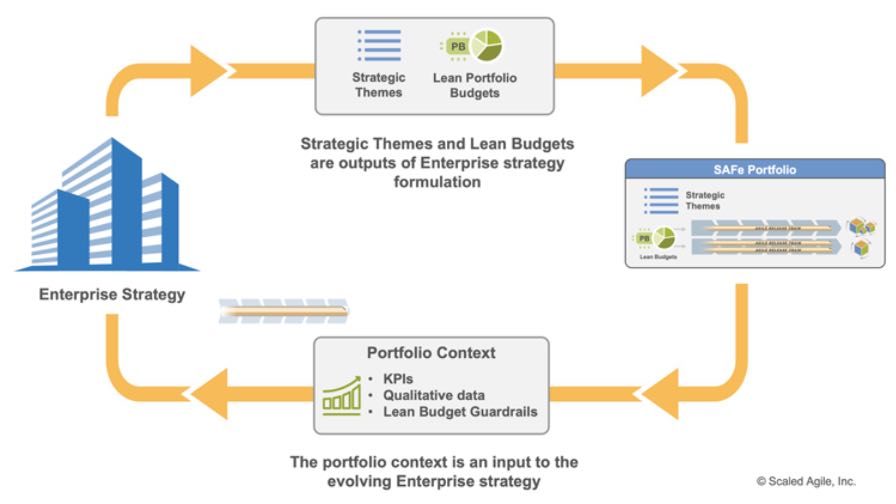
SAFe uses the term "strategic theme" for the definition of business objectives. These should be formulated in such a way that the intended difference between the present and the future is clearly recognizable.
These business objectives are the top-level reference point for the entire company and as such are the starting point for all divisions or organizational units to further detail them and ensure that they are aligned.
OKRs are integrated into SAFe as a technique or "template" for defining strategic topics. SAFe recommends this format to ensure a simple formulation for the goal in combination with metrics to measure progress.
The figure below shows an OKR example for an online community platform.
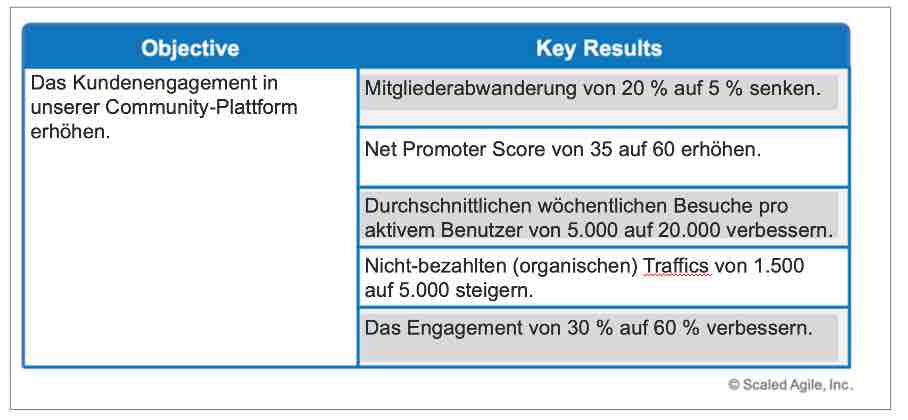
There are two primary fields in the OKR template:
- "Objective: a memorable description of what you want to achieve. An objective should be short, inspiring and challenging.
- "Key Results": a set of metrics that measure your progress towards the strategic theme.
For each objective, there should be a set of two to five key results. The aim of using OKRs for strategic topics is to define and track their progress through concrete, specific and measurable actions.
Note: These frameworks or methodologies are often added to SAFe in a "clunky" and oversimplified way at the beginning. They are then better integrated in later versions. This happened with other frameworks such as Lean Startup, Design Thinking and DevOps.
Can the OKR approach complement the SAFe framework?
OKRs have their origins in start-up companies and areas where the aim is to "disrupt" the established market in the short term. The relatively small organization wants to learn, discover new paths and grow in a complex, highly dynamic context. The business goals are set ambitiously - they are often described as a "stretch" or "moon shot". In such a context, it is considered a success if the targets are achieved 60-70% of the time. Failure is an important part of the process.
In most organizations where SAFe is implemented, it is important to fulfill customer orders. The environment has a certain dynamic, but the challenge lies in managing the size and complexity of the problem and the implementation team. Goals are set so that they are "commitments" or obligations. Failure is not pleasant or even dangerous. Such goals are called "Roof Shot" as opposed to the "Moon Shot" goals of startups.
Similarities and differences between SAFe and OKRs
SAFe and OKR both pursue a holistic, cross-divisional improvement of the corporate value stream. Both provide a framework for large initiatives that are derived from strategy and defined with outcome-oriented goals and metrics. Both are suitable for dynamic, complex contexts because they both enable agile reprioritization of initiatives to align with the evolving strategy.
SAF's focus is on improving the performance of the product development area by reorganizing into agile product-oriented cells that deliver incrementally at a high frequency with a common focus. OKR's focus, on the other hand, is more on the joint reorientation of the company's business without questioning the established organization.
You can also find out more about OKR here.

Comments
Write a comment